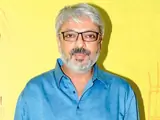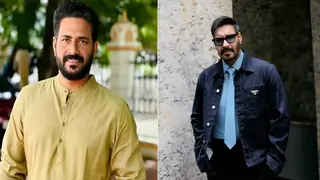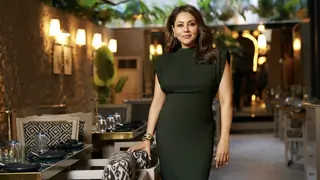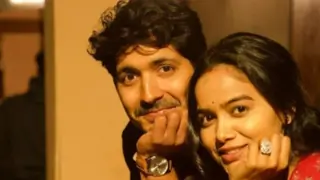'I'm a little strange. So maybe my characters are slightly off'
Three years after Saawariya was hooted off the screen, Sanjay Leela Bhansali is back with Guzaarish. In an interview with Harneet Singh, he looks back at that debacle and defends his cinema — from hyper-real characters to his fixation with disability. And why the colour blue. Excerpts:
How would you describe the three years between Saawariya and Guzaarish?
They have added to my understanding of life and people. I got to know those who really stand by me, and those who only claim to stand by me. I questioned myself a lot, if I'm as fearless as I was when I started. Do I still want to make the films that I want to, and which might not necessarily cater to commercial conventions? I introspected a lot and realised that I'm still the same filmmaker. I'm still in love with life.
What lesson did you learn from the debacle of Saawariya?
Look, I believed in Saawariya as much as I did in Black. Maybe people didn't connect to Saawariya. Maybe some of them genuinely didn't like it, or maybe some of them were told not to like it. Saawariya is the most beautifully shot film of my career.
If you could change one thing about Saawariya, what would it be?
I love the film. I'd still make the same film.
Would you change the release date?
In retrospect, yes, maybe I would.
So you agree that the war with Om Shanti Om took a toll on your film.
I don't want to look back. I don't think anyone should reduce the industry to a level where we need to wage a war. All of us are here to make films and I think we must find joy in what we do.
Have you been in touch with the Om Shanti Om camp?
Look, I've no issues with anyone. I'm happy and comfortable with everyone in the industry. There is no bitterness, which I think shows my groW*H in these three years. At the end of the day, we are all responsible for our karma. I'm looking forward to Guzaarish now.
What was the starting point for Guzaarish?
It's the story of a man who understands the joys of life after going through a crisis. He is someone who has lived a full life, but is at a stage where he isn't enjoying life. So he makes a request which may not be easy to understand, but that's his request.
The film deals with euthanasia. Is it similar to the Javier Bardem-starrer The Sea Inside?
That's like asking me if every blind, mute girl's story is Black. Are all films on cricket Lagaan? Are all films on a woman dacoit Bandit Queen?
So you are saying that Guzaarish is not inspired by The Sea Inside.
My film has nothing to do with The Sea Inside. Maybe the subject is the same but my characters are different, their stories are different. There has never been a mainstream Indian film on this topic. It's the happiest film I've ever made and also the toughest. This film demanded that my entire team and I, especially Hrithik (Roshan), give a piece of our soul to it. It's not a film with an item number that you can go and throw money at. It's a film you'll carry home.
Can you ever make a film with an item number?
I will. But I think that now is the time when mainstream cinema needs to go to a new level. Years ago, we had films like Sujata and Bandini; directors like Bimal Roy and Vijay Anand took up great subjects. But now, when somebody attempts something new, we have a tendency to question it.
You have often been attacked for your cinematic choices. Are you aware of the criticism that follows you?
I've heard some of these stories. I'm sure I'm criticised for 300 things. But is there any director who doesn't get criticised?
In your case, there is a long list. Let's start with your characters. Be it in Black or Saawariya, they don't seem to be rooted in reality. Where do they come from?
They emerge from the heart. I'm a little strange. So maybe my characters are slightly 'off'. They live in my head and I bring them to the screen. I've a way of looking at life. If I see a blind, mute girl, I start thinking: what if she has a story? What if she wants to study? What if she graduates at 40? And that's how Black happened.
But the world you create seems to exist beyond time and space. It's difficult to ascertain which period your films are set in.
There are genres of cinema and styles of film-making. Satyajit Ray made realistic films, while (Federico) Fellini made abstract cinema. But Fellini is as important as Ray. (Akira) Kurosawa makes a stylised statement in all his films. If by real, you mean putting a camera on a road in Bhendi Bazaar (Mumbai), then my argument is that anyone can do that. Why can't I create my own road? Don't take my style away from me. It's like telling a painter not to use a particular colour.
And what about your penchant for the colour blue?
How come nobody noticed the grey-black palette in Black, the gold-yellow in Devdas and the red in Hum Dil De Chuke Sanam? All my films have distinct colour tones. But it became a big issue with Saawariya. People who I thought were my friends sat at the premiere and messaged the world about the blue tone. In Saawariya, the blue symbolised Krishna. We work like mazdoors to get the visuals right. How can people nullify all the work we put in by saying iski toh har film neeli hoti hai? I hope nobody demands an apology from James Cameron since he used blue in Avatar.
In Khamoshi, Black and now Guzaarish, where Hrithik is a paraplegic, you show characters with disability. Don't you think you end up manipulating the audience emotionally?
Never. In fact, in Black, I was criticised because the teacher was rude and harsh to the student. I wanted it like that, because he treated her like a normal person. When I made Khamoshi, I showed how a deaf and mute couple became jealous when their daughter fell in love. They were scared that she would leave them. In Black, the girl wants to know what love is, and even asks her teacher to tell her. There was never any manipulation. I'm comfortable aesthetically and emotionally while making these films.
But you have to admit that your films give a depressive high.
Not really. I think my films are cathartic, they churn my audience. You have to know that my films come from my soul. My past resonates in my mind for years, and when I feel I can deal with these emotions, I give them harmony and form and make a film.
Do you feel that over the years, the opulence of craft has taken over your cinema?
I don't think so. The quest for perfection is a part of me and so it is bound to reflect in my films. You can call it opulence or operatic. I call it my vision.
Weren't you supposed to make Guzaarish with Salman Khan?
No, I never went to Salman with this script. I was supposed to make Bajirao Mastani with Salman but somewhere along the way, Guzaarish just emerged. I always want to work with him and I know that he is my one and only friend in this industry.
In the beginning of your career, you said you wrote all your scripts with Madhuri Dixit in mind. Has Aishwarya Rai Bachchan taken over that space?
Oh, completely. By the time I found Madhuri, she was at her peak. But in Ash, I've found a soul mate and a friend. I'm convinced that I knew her in another lifetime.
You earned quite a reputation for throwing your assistants' cellphones in anger. Have you learnt any new tantrums?
(Laughs) My cellphone phase is over. Now I'm very peaceful. Over the years, I have realised that this urge for excellence is something you are born with. I can't drill it into everyone. But I do tell my assistants that if they make a mistake, I have to pay for it all my life since it's recorded for eternity. Every filmmaker gets angry, but I was made into a monster. Now I don't get angry.
Since you've also composed the music for Guzaarish, who were your inspirations?
Lata Mangeshkar who I listen to every day. Jaidev, Madan Mohan and Roshan saab.
Name some contemporary filmmakers whose work you like.
My contemporaries change every two years. Vikramaditya Motwane, who was my assistant, is now a contemporary. I don't want to name or rate anyone. I'd like to keep my opinion to myself. We are all fine. Nobody has arrived. Even I've not arrived.
Are there any films that you regard as textbooks and keep going back to?
Meghe Dhaka Tara, Mirch Masala, Ram Teri Ganga Maili, Pakeezah, and all the films made by Kurosawa.





































1